
‘Fried rice syndrome’: Dietitians warn against eating food left out at room temperature
Food safety experts have been taking to TikTok to warn against fried rice syndrome and what causes it. Fried rice syndrome is a type of food poisoning which occurs when certain dry foods, such as pasta and rice, contain a bacterium called Bacillus cereus that produces a toxin when heated and left out too long, according to the Centers for Disease Control and Prevention. Concern over the food poisioning has grown recently after reports of 20 year old dying in 2008 from eating five-day-old pasta circulated on TikTok. The concern over the possibility of food poisoning from leftovers has prompted dieticians and other food safety officials to explain what temperatures are and aren’t safe for leftovers. Kyndall Weir is a sports dietician who goes by the username @theathletedietitian on TikTok. In her video, she recalled one of her clients who was eating from the same pizza every week without storing it in the fridge. She then explained why doing something like that can be dangerous by referring to the “temperature danger zone,” which is echoed in the US Department of Agriculture’s Food Safety and Inspection Service’s food safety website. “If something is supposed to be refrigerated and it reaches above 40F degrees, bacteria can start to grow,” Weir explained. “On the other hand, something that is supposed to be hot, like that rice that was cooked, cools down below 140F. That is also in the temperature danger zone.” People had so many questions that the TikToker began a food safety series on her page. One person asked, “Can I heat food up [and] put it directly back in the fridge hot? Bc I heard that’s bad but I do it secretly. BUT I will stop if I should.” Weir responded, “Technically you should let it cool before putting it back in the fridge.” But Weir isn’t the only content creator speaking out about food safety and fried rice syndrome. Dr Shazma Mithani, who goes by the username @drshazmamithani, also posted about the same subject. @theathletedietitian #stitch with @Jpall20 #greenscreen why food safety is so important!!! Im immediately turning this into a series #athletenutrition ♬ Spooky, quiet, scary atmosphere piano songs - Skittlegirl Sound “Do not leave starchy food like rice, pasta, or potatoes out at room temperature,” she warned in the video. “There’s a very specific bacteria that thrives in this environment and produces a toxin that is heat stable, meaning that even when you reheat the food, it does not kill that toxin.” She included more information in the caption, where she clarified that leaving out leftovers longer than they should is usually not a problem, but “starchy foods” can be more prone to the bacteria exposure than other foods. @drshazmamithani Share this to keep your friends and family safe! We are all guilty of letting food sit out for longer than we would like to. Often, it’s not a big deal, but for starchy foods like rice, it’s the perfect breeding ground for a bacteria called Bacillus cereus. This bacteria produces a heat stable toxin that survives even when the rice is reheated. It’s can cause severe vomiting, diarrhea, and dehydration. Please share this and follow for more tips and tricks to keep you and your entire family healthy and out of the ER. . . . . . #foodsafety #food #rice #pasta #potatoes #toxin #bacteria #foodpoisoning #vomiting #diarrhea #er ♬ original sound - Dr. Shazma Mithani, MD, FRCPC According to the USDA, best practices for safely storing hot leftovers is to refrigerate leftovers within two hours of cooking the food or after it is removed from an appliance keeping it warm. After food is safely cooked, hot food must also be kept hot at 140F or warmer to prevent bacterial growth. With cold food, it should be discarded after sitting at room temperature for over two hours, and one hour if it’s been sitting at a temperature above 90F. Read More ‘It can be hard when your kids leave the nest,’ mother says as study finds parents want their children back Sitting this many hours a day ‘rapidly increases’ dementia risk, study warns Woman warns not to ignore symptoms after hot flushes lead to leukaemia diagnosis Schoolboy almost dies from swallowing magnets for TikTok challenge Woman shares honest review of New York City apartment TikTok mom slammed after making 5-year-old son run in 104 degree heat
2023-09-14 04:50

Dunkin's newest pumpkin drink contains actual donuts
Dunkin' is elevating the pumpkin drink wars with, what else, donuts.
2023-09-13 11:18

The dish that defines me: Michele Pascarella’s Neapolitan ragu
Defining Dishes is an IndyEats column that explores the significance of food at key moments in our lives. From recipes that have been passed down for generations, to flavours that hold a special place in our hearts, food shapes every part of our lives in ways we might not have ever imagined. I was very young when I started working in a local pizzeria in Caserta, the city near Naples where I grew up. I was 11 years old when I started working there, and stayed on for about eight years before moving to London to start my own business. But during my teenage years, one of the best memories I have is waking up to the smell of my mother’s ragu on Sundays. Neapolitan ragu is a specialty in the region, and we are very proud of it. It’s one of the two most famous varieties of ragu, the other being ragu bolognese, and uses whole chunks of beef and pork rather than ground meat. It must be cooked for a long time over a low heat, for at least eight hours, preferably 10 hours. My mother would get up at 5am to start making hers and it would continue to simmer slowly until the family is ready to eat in the afternoon. Sundays are special because it’s a time for the whole family, including our extended family, to come together and eat at the same table. My family comprised of my parents, my three siblings and myself, and we would usually be joined by my grandparents, aunts, uncles, cousins. We usually had anywhere between 15 to 20 people gathering on Sunday afternoons. It didn’t matter what commitments you had – on Sunday, you have to sit at the table with family. It’s the most important day of the week for us. The ragu is the dish that, for me, brings everything together: passion, love, happiness and strong ties with family. Because I worked late shifts often, I would wake up really late on Sundays, around 11am or 12pm. So by the time I wake up, the beautiful aroma of the ragu that has been cooking since 5am will have filled the whole house. I would wake up so hungry. My breakfast on these days would simply be a hunk of bread, torn and dipped straight into the still-simmering sauce, with some parmigiano reggiano sprinkled on top to help cool it down. Every family has their own way of eating ragu. You can dip bread in it, like I did for breakfast, but it is most commonly eaten with pasta. Some people have it with gnocchi while others might use a short pasta or spaghetti. But it does have to be a robust pasta shape, you can’t have ragu with a really small pasta, or it won’t stand up to the sauce. No one makes ragu like my mother’s. I could go to any restaurant, even those with Michelin stars, and it wouldn’t come anywhere close to hers. I strongly believe her secret ingredient is just her love for cooking for her children, as the dish needs that passion to make it taste so good. I never woke up at 5am to try and make it with her, it was so hard when I was a teenager! But when I did start to learn how to make it, it was very difficult to get up that early. I don’t know how she did it for so many years. In my restaurant, Napoli on the Road, I make a pizza with the slow-cooked ragu as a topping, along with a parmigiano reggiano cream. I call it Ricordi D’infanzia, which translates to “childhood memories” because it holds such strong nostalgia for me. But I still can’t make it like my mother does. When I go home to Caserta to see my family, I do try to wake up at 5am to make it with her. I’m less stressed about work when I’m there so I can usually do it, but when I’m back in London it’s hard to get up at that hour when you finish at midnight at the restaurant. Like most mothers who pass down their recipes, there are no accurate measurements to my mother’s ragu. Sometimes they put some sort of secret ingredient inside and won’t tell you. But I have learnt that you need to be flexible about it, depending on what ingredients are available to you. For example, maybe the tomatoes you buy from the market are too acidic. My mother fixes this by putting a whole potato in the sauce, because its starchiness will help to remove the acidity from the tomatoes. Or, she might add sugar to the sauce to mellow it out. It can be tricky to get it right, so I can only try my best to do better than my mother, but it is hard. I think I will be 80 or 90 years old before I perfect my own version! I’ve lived in London for almost 20 years, but I still miss those Sunday afternoons spent with my family at my uncle’s or grandfather’s house. In London, things are very fast-paced and rushed, you don’t really have time to sit down with people. I try to go back every couple of months, and I really look forward to it. My mother still makes her ragu. Even though nowadays it’s harder to get everyone together, we do our best to keep everyone united. I don’t have any family in London, so it’s important to me to keep that tradition alive when I go home. My dad has never visited me here because he is afraid of flying, but my mother comes fairly often and I’ll make ragu for her when she does. She never says anything bad about it – although, she will tell people: “It’s good… but it can be improved.” Still, I’m glad I have the opportunity to make it for her sometimes and it keeps me connected to home. Michele Pascarella is the chef-owner of Napoli on the Road. Read More The dish that defines me: Evelin Eros’s rum cake The dish that defines me: Mallini Kannan’s baked honey-soy salmon The dish that defines me: Frank Yeung’s prawn wontons
2023-09-12 13:46
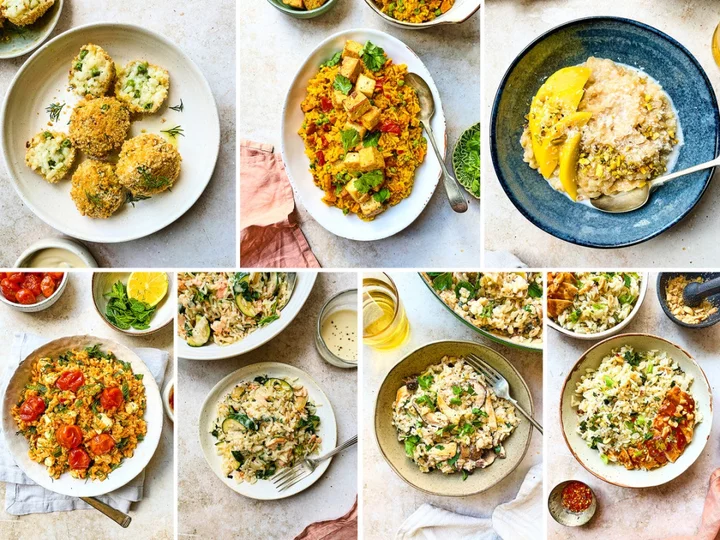
Seven super simple recipes for each day of National Rice Week
National Rice Week, back this September (11-17 September), is the perfect opportunity to widen your recipe repertoire and discover great value meal ideas to feed all the family. The annual campaign run by the UK Rice Association aims to raise the profile of the British rice sector and encourage more people to choose rice, whether that’s demonstrating the simplicity of cooking it at home or being first choice when eating out. Showcasing dishes using a variety of rice grains, we’ve got seven super simple new recipes for you to try, all of which are tasty, easy to follow and make the most of leftovers and store cupboard staples – like rice! Not only is rice super versatile – in fact, rice is one of the few foods that can be enjoyed sweet or savoury, hot or cold and for every meal of the day – it is also gluten-free and offers a host of nutritional benefits too. With seven dishes using seven types of rice, there’s a new recipe to try every day of the week. Creamy mushroom and chicken rice Serves: 4 Prep time: 5 minutes | Cooking time: 30 minutes Ingredients: 1 tbsp olive oil 2 leeks, trimmed, cleaned and sliced (230g) 3 garlic cloves, sliced 300g mushrooms, sliced 300g Bomba rice 1 litre chicken stock ½ pack (10g) flat-leaf parsley, chopped 4 tbsp sour cream 2 chicken breasts (skin off) Method: Preheat the oven to 180C. Heat the olive oil in a heavy-based casserole dish over a moderate heat, add the leeks and cook for about 6-7 minutes until soft. Add the garlic and mushrooms and cook for a further minute. Add rice, stock and give the rice a good stir. Cover the pan and bake in the oven for about 25 minutes or until the rice has absorbed all the liquid and the grains are just cooked through. Stir in the parsley, sour cream and season to taste. In the meantime, pan fry the chicken in a non-stick pan with a little oil until cooked throughout. To serve, chop up the chicken, then add it to the pan with the rice. Mix to combine. Sprinkle with fresh parsley. Cooks tip: Add some chorizo for extra flavour. Sticky chicken rice bowls Serves: 4 Prep time: 10 minutes | Cooking time: 20 minutes Ingredients: For the rice: 6 spring onions chopped (90g) 1 tbsp coconut oil/olive oil 200g Jasmine rice 400ml coconut light milk 200ml water For the dressing: 1 tbsp maple syrup 1 tsp brown rice miso 1 tbsp soy sauce 1 tbsp rice vinegar 1 tbsp sriracha 1 tbsp toasted sesame oil 2 chicken breasts (skin off) 1 tbsp olive oil To serve: 2 tbsp crushed roasted peanuts Handful coriander/mint 1 spring onion sliced Method: To make the rice, fry the spring onion in a large pan with the oil. Now add the rice, coconut milk and water. Stir then cover pan with lid and simmer until the liquid is absorbed (12-14 minutes). Once the liquid is absorbed, turn off the heat keeping the lid on the rice for 10 minutes. Season to taste. For the dressing, add all the ingredients to a jar and mix to combine To cook the chicken, pre heat oven to 180C. Score the chicken breasts and heat the oil in a griddle or frying pan. Cook the chicken for 7-8 minutes on one side, then flip and cook for 4-5 minutes. Transfer the chicken to a large baking tray and spoon over the dressing. Bake for 5 minutes until they are bubbling. To serve, spoon the coconut rice into bowls, top with the chicken and all the garnishes. Cook’s tip: You can swap the chicken for salmon, tofu or aubergine. Herby rice with harissa roast tomatoes and feta Serves: 4 Prep time: 5 minutes | Cooking time: 25 minutes Ingredients: 200g brown rice For the tomatoes: 300g cherry tomatoes 1 tbsp olive oil For the harissa dressing: 2 tbsp harissa/rose harissa 4 tbsp extra virgin olive oil 1 lemon juice To stir in: 150g feta 10g fresh dill, chopped 15g fresh mint, chopped Method: Cook the rice as per pack instructions. To cook the tomatoes, preheat the oven to 180C. Add the cherry tomatoes to a large baking tray and toss them in 1 tbsp of olive oil. Bake on for 20-25 minutes or until soft and browning a little. Set aside. To make the dressing, add all the ingredients to a jar and mix to combine then season to taste. To sever, toss the rice with the dressing, fresh herbs and feta. Top with the roast tomatoes. Cook’s tip: Make a vegan version by swapping the feta for vegan feta or crispy tofu. Rice salad with salmon, greens and lemon tahini dressing Serves: 4 Prep time: 5 minutes | Cooking time: 20 minutes Ingredients: 200g long grain rice 2 salmon steaks (240g) 1 onion, sliced 100g cabbage greens 1 courgette sliced (200g) For the lemon tahini dressing: Juice of ½ lemon 2 tbsp runny tahini 1 tbsp olive oil 50ml water To serve: Fresh mint Method: To make the rice salad, cook the rice as per the pack instructions. Drain and set aside. In the meantime, pan fry the salmon steaks on a little oil for 2-3 minutes on each side. Set aside and flake up when cool. In a separate frying pan, add the onion and fry for 5-6 minutes. Now add the cabbage and courgette and fry for 2-3 minutes. Add in the cooked rice. To make the dressing, add all the ingredients to a jar and mix to combine. To serve, add the rice and greens to a large bowl, add the flaked salmon and toss lightly to combine. Serve with dressing and fresh mint. Cook’s tip: This also works well with a harissa or classic vinaigrette dressing. Veggie biryani with crispy tofu Serves: 4 Prep time: 5 minutes | Cooking time: 25 minutes Ingredients: For the biryani: 1 tbsp olive oil 1 onion, sliced finely (120g) 2 carrots, chopped up finely (200g) 3 cloves garlic, minced ½ red chilli or ½ tsp chilli flakes 1 tsp turmeric 1 tsp garam masala 3 tomatoes, chopped (350g) 200g basmati rice 500ml vegetable stock 1 can coconut milk (400ml) 150g frozen peas For the crispy tofu: 1 x 200g block firm tofu cut into medium-sized slices 1 tbsp oil To serve: Fresh coriander Method: To make the Biryani, add the oil to a large saucepan pan, heat to medium then add the onions, carrots, garlic, chilli and spices. Fry on a low heat for approx 6-7 minutes until soft. Now add the tomatoes, rice, stock and coconut milk – simmer until the rice is cooked (15-20 minutes) Stir in the peas 2 minutes just before the rice is cooked. Season to taste. To make the crispy tofu, heat a frying pan to medium and add the oil to the pan. Add the tofu to the pan, fry on each side for a few minutes, turning carefully until crispy. To serve, top the rice with the tofu and fresh coriander. Cook’s tip: The rice works really well with prawns or chicken. Sticky mango rice bowls Serves: 4 Prep time: 5 minutes | Cooking time: 20 minutes Ingredients: 100g sushi rice, pre-soaked 250ml plant based milk ½ can coconut milk (200ml) 3 tbsp caster sugar 1 tsp vanilla extract To serve: 1 ripe mango sliced 4 tbsp desiccated coconut, toasted Pistachios Method: In a medium pan, combine the sushi rice, plant based milk, coconut milk and sugar and stir well. Bring to the boil, then reduce the heat and simmer gently, stirring occasionally, for 12-15 minutes or until the rice is tender and has thickened. Stir in the vanilla extract. To serve, divide into bowls and top with the mango, coconut and pistachios. Add a little additional coconut milk if needed. Cook’s tip: This makes a lovely dessert but also can be eaten in the morning for breakfast. Cheesy pea arancini with garlic mayo Makes: 16-18 Prep time: 5 minutes | Cooking time: 25 minutes Ingredients: For the arancini: 800g leftover risotto of choice 150g frozen peas, defrosted Juice of ½ lemon 100g mature cheddar grated To coat the arancini: 200g toasted bread 50g plain flour 2 eggs, beaten with 1 tsp water To serve: Garlic mayo Fresh herbs Drizzle of extra virgin olive oil Method: To make the arancini, mix the leftover risotto with the peas, lemon juice and cheddar, seasoning to taste. Scoop up a golf ball sized amount and roll into a ball. Place the balls on a plate ready for rolling. To make the crumb, break up the toast a little and add to your food processor and blitz until you get a fine crumb and add to a shallow dish. Add the plain flour to a shallow bowl and the beaten egg to another. Roll each arancini in a little flour, then egg and finally coat in the breadcrumbs. Repeat. Drizzle a baking tray with olive oil and add the balls. Bake for 25 minutes – turn halfway through. To serve, top with a little olive oil and fresh herbs. Cook’s tip: Also delicious with some mozzarella in the middle of the arancini instead of the cheddar. For more information see: www.riceassociation.org.uk or www.facebook.com/TheRiceAssociation Read More Three healthy recipes to get back on track after summer Is bottomless prosecco going to be killed off by climate change? Budget Bites: Three ways to pimp up university student classics Epicurus: American fast food meets the Middle East in Camden Market ‘How being thrifty in the kitchen helped me get on the housing ladder’ How to make spinach and mushroom quiche
2023-09-11 13:52
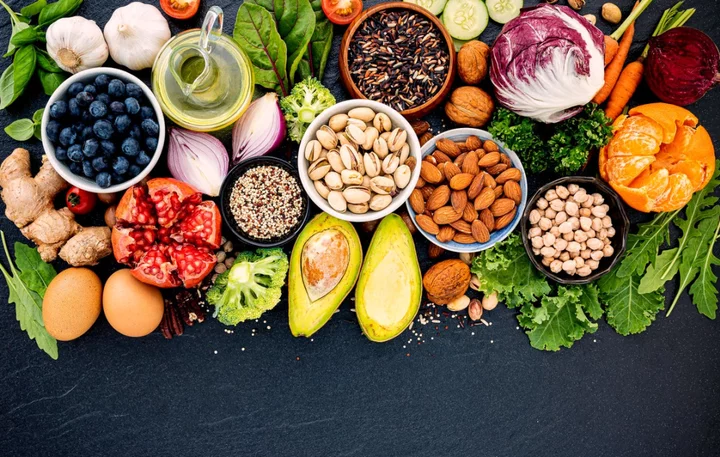
What are Blue Zones and how do they impact your health?
The secret to living a longer life isn’t found in some elixir or fountain of youth. Rather, it’s said to be found in Blue Zones. Blue Zones are the five regions in the world where people are known to live long, healthy lives. These areas are Okinawa, Japan; Sardinia, Italy; Nicoya, Costa Rica; Ikaria, Greece and Loma Linda, California. Here, the foods people eat aren’t just part of some diet - it’s a way of life. The term Blue Zone was popularised by Dan Buettner, a National Geographic journalist who travelled the world studying the cultures of these thriving communities. In a 2020 master class hosted by the Global Wellness Summit, Buettner shared the foundation of living in a Blue Zone: “The big epiphany of all these Blue Zones is that long-lasting health is very rarely successfully pursued; it ensues.” Now, not everyone can pack their bags and whisk themselves off to Italy, but there are many ways to adapt your daily routine to the Blue Zone lifestyle. Here’s what we can learn from these regions: Fibre, fibre, fibre Foods rich in fibre are prominently featured in the diets of those living in a Blue Zone. Beans and whole grains like brown rice and quinoa are high-fibre ingredients that can lengthen your life. Fruits, vegetables, and legumes are also natural sources of fibre. Fibre plays a key role in promoting gut health, managing your weight, and reducing cholesterol levels. Research shows that children and adults need at least 20 to 30 grams of fibre per day, but most Americans get only about 15 grams a day. Whether it’s garbanzo beans in Greek hummus to black beans in Costa Rican soup, increasing your fibre intake is key to living a longer life. Move naturally You don’t need to work out at the gym five times a week to increase your longevity. In fact, residents in Blue Zone areas rarely workout at all, as their exercise mostly comes from activities done throughout the day, such as walking and gardening. Incorporating 20 minutes of movement in your daily routine is just one way to live the Blue Zone lifestyle. Maintain a positive outlook On average, Americans spend nearly five to six hours on their phones a day, from the moment they wake up to the moment they go to bed. Instead, begin your daily routine with a positive meditation, or separate the work day with mini stress breaks. In Blue Zones, residents shed their stress by engaging in sacred daily rituals, such as remembering their ancestors in Okinawa or taking naps in Costa Rica. Or, do like the Sardinians do: happy hour. Connect with others Curating a social circle is one of the main pillars of living in a Blue Zone. In an era of Zoom calls and work from home, connecting with those around us has proven to be a little more difficult than in years past. Even if it’s just a small group, engaging with others who keep you active, eat a similar high-fibre diet, and care about you on a bad day can help you live until you’re 100. Read More 11 best healthy food subscription boxes delivered right to your door 10 best exercise bikes for smashing your fitness goals at home Five waste-free recipes to take your Veganuary up a notch What are Blue Zones and how do they impact your health? Three healthy recipes to get back on track after summer Best burgers in London: Where to eat top patties in the city
2023-09-09 03:23
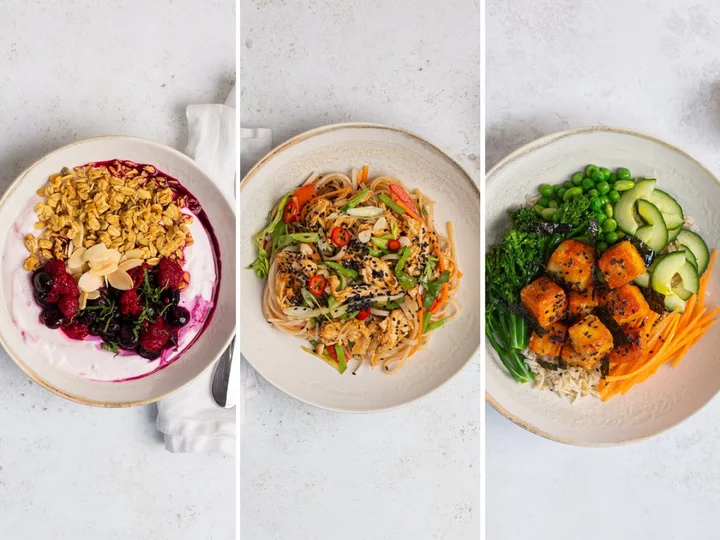
Three healthy recipes to get back on track after summer
With September often thought of as a second January, it’s the perfect time to set goals and form new habits. Meal prepping is a great way to help you stay on track and reach your goals. Benefits include helping you to stick to healthier foods, saving money, minimising food waste, saving time and reducing stress. Sophie Dillon, head of nutrition at Fresh Fitness Food, has put together a few nutritious recipes (breakfast, lunch and dinner) that take less than 30 minutes to prepare and cook. Yoghurt and granola with berries Greek yoghurt is a great source of protein, and can also be beneficial for your gut, as it is a food-sourced probiotic (so long as it’s labelled to contain live cultures), and this homemade granola recipe is packed with slow-release carbs, providing a sustained energy release for your morning, and to help keep your blood sugar levels more stable. Tip: Batch-cook your granola and store in an airtight container for ease and an on-demand, nutritious addition to your yoghurts, smoothies, or if you just fancy a simple carby snack. Serves: 2 Time: 25 mins the first time, 5 mins once you have the granola on hand Ingredients: Handful of berries of your choice ½ cup ricotta cheese ½ cup Greek yoghurt ½ vanilla pod 1 scoop of vanilla whey For the granola: 50g buckwheat groats 100g oats 20g maple syrup 5ml olive oil ½ tsp ground ginger Method: 1. Blend the ricotta cheese till smooth and then mix in the Greek yoghurt, vanilla pod and whey protein. 2. Preheat the oven to 170C. 3. Place all ingredients for the granola into a bowl and thoroughly mix together. 4. Line a baking tray with some grease-proof paper, pour the granola mix onto the tray and pop in the oven for 10 minutes. 5. After 10 minutes, remove the tray and mix around the granola to break up any large clumps. 6. Place back into the oven for a further 10 minutes, then take out to cool. 7. Place the yoghurt in a bowl and top with granola and the berries of your choice. Bang bang chicken stir-fry Quick, easy meals are key when it comes to nailing your fitness goals, and this stir-fry is an easy lunchtime winner. We’d recommend cooking an extra couple of portions and popping them in the freezer for an easy dinner on busy days. Tip: If you end up with extra chicken, put it to the side to have in a bang-bang chicken salad. Serves: 2 Time: 15 mins Ingredients: 2 chicken breasts, cut into strips ½ juice of a lime 1 tbsp peanut butter ½ tsp tamari sauce ½ tbsp sriracha ½ carrot, julienne or grated ½ red pepper, sliced 1 spring onion, sliced 1 tbsp oil of choice (we recommend sesame for a nice, nutty flavour) 3 nests rice noodles ½ tbsp sesame seeds (optional) ½ red chilli, sliced and de-seeded (optional) Method: 1. Mix together the sriracha, lime, salt, lime, peanut butter and tamari thoroughly with a whisk. 2. Mix all ingredients together so the chicken is well coated 3. Heat the sesame oil in a wok. Once hot, add the chicken to the pan, and cook until golden. 4. While the chicken is cooking, cook your noodles per the instructions on the packet, and leave to stand for one minute before adding to your pan. 5. At the same time, add your carrots and red pepper and stir until everything is coated in the sauce/oil mixture. 6. Once the chicken is cooked and the veg is soft, mix in your spring onions, and plate up. 7. Garnish with sesame seeds and chilli, if desired. Crispy tofu poke bowl Tofu is a great source of plant-based protein, containing all the essential amino acids your body needs. It’s also rich in vitamins and minerals, including calcium, iron and vitamin A. The great thing about crispy tofu, aside from its nutritional benefits, is that it works just as well in leftovers, too. Throw it in a tofu satay curry, pad thai or into a salad for a plant-based protein boost. Serves: 2 Time: 30 mins Ingredients: 1 block of firm tofu 1 tbsp olive oil ½ tsp smoked paprika 1 tsp cornflour ½ carrot 100g cucumber 50g edamame 50g peas 150g uncooked rice 100g tenderstem broccoli 1 tbsp sesame seeds (optional) 1 nori sheet, sliced into strips (optional) Salt to taste Method: 1. Drain the tofu and cut into equal-sized pieces. 2. Mix the tofu with cornflour, salt, olive oil, smoked paprika, and tofu together. 3. Roast on lined trays at 190C until brown and crispy – around 20 mins. Drain once cooked. 4. While the tofu is cooking, cook your rice as per the instructions. 5. In the meantime, prepare your veg. Chop and de-seed your cucumber. 6. Steam your tenderstem, peas and edamame. 7. Once your tofu is crispy and your rice is cooked and drained, plate everything up, and garnish with the nori and sesame seeds. Read More Is bottomless prosecco going to be killed off by climate change? Budget Bites: Three ways to pimp up university student classics Epicurus: American fast food meets the Middle East in Camden Market ‘How being thrifty in the kitchen helped me get on the housing ladder’ How to make spinach and mushroom quiche For a quick sugar fix, try this Biscoff microwave mug cake
2023-09-08 16:59

Best burgers in London: Ranking the capital’s burger joints
Yes, the omnipresence of burgers in London is getting a little overbearing and yes, we've seen about every permutation of them by this point - but this does nothing to tarnish their inherent deliciousness, godamnit! Here are London's finest patties as we see it. 10. Electric Diner/Soho Kitchen and Bar Burger Very similar to the burger at Chicago’s Au Cheval, often rated among America’s best, the cheeseburger at Electric Diner (and Soho Kitchen and Bar) is a delightful assault on the senses. Go for a single and you get two patties; a double comes with three. The patties are thin enough to not be a belly bomb and are accompanied by a profusion of pickles, onions and a tangy, mustardy mayo. Joint Exposed brick, leather booths and a long bar with stools all feature, but don't overwhelm with kitsch at either venue. Both are bright and airy and basically quite pleasant to be in. Feels more like the Upper East Side than Uxbridge, which is a positive. 9. Elliot’s Burger Beer-braised onions, Comté cheese, buns that they bake in house and possibly the beefiest beef in any burger on this list all combine to grant Elliot’s its spot. The dill butter complements wonderfully and provides the classic ‘Big Mac’ taste that most of us grew up with. Joint Quite similar to the Electric/Soho Kitchen & Bar, but with the seats packed in and the constant hum reminding you you're in Borough Market. It can get a little noisy, but there's really no time for talking when you're in zen burger-eating mode anyway. 8. Byron Burger Long gone are the days of floury baps and just trying too hard. Nowadays Byron is selling burgers so good that they make the stock opinion of chain restaurants always being bad seem ridiculous. The basic menu is short, to-the-point and has possibly the best burger readily available to most Londoners. Rotating specials are always on point and the Smoky, which recently went full-time, should be your burger-of choice (those crispy onions!) Vital to the London burger ‘scene’. Joint Byrons vary hugely depending on the location, which is again refreshing for a chain. Go to Kensington and you'll see dadaist wall doodles and diner stalls, head to Angel and you'll find a peeling shack with patio furniture. 7. Shake Shack Burger Fine, it’s an American chain and fine, you probably can’t imagine why people would queue up for a burger - but trust us, Shake Shack brings one of the finest examples of truly American food available in London - an ode to the Steak ‘n’ Shake chain. Juicy beef is topped with bright American cheese, nestled in a steaming Martin’s Potato Roll. Get the SmokeShack, which is topped with smokey bacon and absurdly tangy chopped cherry peppers. Joint McDonald’s dressed up for an Ofsted inspection. A bit on the clinical inside, and out in Covent Garden piazza you’re met with the furious din of tourists and spontaneous opera, but it does the job and there's ample seating and an insanely high volume of helpful staff. 6. MeatLiquor/MeatMarket/MeatMission Burger The MeatWagon produced the burger that changed London’s dining scene and made sure hamburgers were a full-blown trend. That was in late 2009/early 2010 and since then things have changed a fair bit, including a few new restaurants (actual restaurants) in the MEAT family. For our money the quality probably goes MeatLiquor, MeatMission, MeatMarket, in that order, but there’s barely much to choose from when it comes to the eating. As more and more rivals have opened up, the MEAT empire has had to ensure quality hasn’t dropped and although they don’t top our list, they’re still producing hundreds of the best burgers you’ll find in London every single day. From the cheeseburger to the Dead Hippie via the Mushroom Swiss, there’s a lot still to like here. Joint Imagine a gothic cathedral with bootleggers and a cult as previous owners and you might have an idea of what MeatLiquor looks like on the inside. It is the most thrillingly decorated of the three restaurants in London and the best if you're there more for the booze than the burgers, with MeatMarket going for a more straight forward fast food vibe, and MeatMission housing stained-glass windows, photo booths and a circular bar with alcoholic slushie machines. 5. Dip & Flip Burger Aah, Dip & Flip! If you’ve never tried a burger and considered just how much better it would be with the addition of gravy, wait until you try one here. The burger to get is the eponymous Dip & Flip - a cheeseburger topped with roast beef and an abundance of gravy. Also not to be overlooked is the patty melt, but whichever way you go, a pot of gravy comes on the side. Make sure you dip. Joint Fun and functional, rather than cosy, you'll probably be in and out (no pun intended) of here within the hour. There's a mix of high and low tables, the former usually occupied by people fuelling up before heading out and the latter usually occupied by families with pushchairs. The music is good and staff are extremely personable. 4. Honest Burgers Burger When Honest Burgers launched a few years ago, they were bizarrely criticised for being a bit too, well, clean. The trend for ‘dirty’ food - particularly burgers - is quite transparent (although possibly on the wane) and Honest seemed to go against that. Their burgers are as straightforward as the name suggests. The beef is 100% ground chuck from The Ginger Pig, liberally seasoned with salt and pepper, as it should be, while the toppings and buns celebrate British produce, with mature Cheddar, Red Leicester and Stilton all available. Honest have since evolved the menu to include rotating specials and the peerless Tribute - their take on a classic American burger, with bacon, American cheese, burger sauce and pickles. It’s a showstopper. Joint Wilfully avoiding the Americana-theme of so many burger restaurants, Honest feels distinctly British. Its restaurants are simple but elegant, putting the emphasis on the burgers. 3. Flat Iron Burger If you’ve never read Hamburger America, George Motz’s indispensable ode to America’s favourite fast food, or seen the complementary documentary, then the name Dyer’s Burgers possibly won’t mean much to you. As Motz explains, Dyer’s is a Memphis institution that’s been around for over 100 years. Their USP? They deep fry their hamburgers. It may sound revolting and it’s definitely not great for you, but you probably won't care after you try a Flat Iron burger, available as a regularly occurring special. It goes without saying that the meat is great quality at this steak restaurant, but the frying gives it an incredible texture; it’s slightly crispy on the outside while also being tender and maintaining a loose structure. The bun is supplied by St John and does a wonderful job of holding everything together - including the outstanding bearnaise sauce and chopped shallots. Follow them on Twitter and go whenever it’s available next. Joint With its white-washed and exposed brick walls and circular metal lamps you feel a little like you're in an abattoir in Flat Iron, which is appropriate given they serve their steaks up on a slab with a mini meat cleaver. Downstairs is all dim candelabras and dark wood and worth heading down to if you can get a seat. 2. Patty & BunPatty & Bun is among the restaurants taking part Burger You know when you see a burger in a TV advert and think, ‘Hey, I’ve never had a burger that looks that good’? Well, Patty & Bun is serving up cheeseburgers that could have been produced in a studio. Or a burger laboratory. Every single aspect has been considered, tweaked and is produced to deliver an outstanding eating experience, every time. The bun, beef and toppings are all superlative - it’s the Real Madrid Galacticos of the hamburger world, in a little package. It could be said that the best (and worst) thing here is the intensity of eating a P&B burger. Whether it’s the Ari Gold, Smokey Robinson or Lambshank Redemption, you’re almost forced to drop your head and not come up for air until you’ve finished eating. You’ll stumble outside and wonder what just hit you. Joint Patty & Bun has a very DIY, pop-up feel inside, with the walls covered with chipboard and the art being scrawled on flattened cardboard boxes. It makes for a laid back atmosphere and the music is always great, avoiding AC/DC cliches and instead going down the Ginuwine, Erykah Badu, Ashanti route. 1. Tommi’s Burger Although it looks like a cartoon hamburger, possibly from a tray carried by J. Wellington Wimpy, Tommi’s is currently producing the best patties in London. The beef is supplied by the exceptional H G Walter, the bun is shiny and soft and the toppings are up to you. Although you can upgrade to slightly more lavish cuts of meat in the form of the steak burger, it’s the regular cheeseburger that gets the nod from us. In some ways it’s like something your dad would produce at a barbecue, if he spent endless summers out there in the rain honing it to perfection. Why is it above Patty & Bun? Essentially it’s the simplicity. Tommi’s is, in some ways, the antithesis of P&B and the former just edges it for us for London’s best burger. Joint Succeeds where many others in London fail by not trying too hard. It’s a burger, not a fillet steak and Tommi’s knows this, taping a few Sopranos posters to the walls, stringing up a couple of sets of fairy lights, writing the specials on some cardboard and calling it a day. There’s something very casual and humble about the restaurant, queues rarely reach the street and there isn’t a hashtag in sight. The most authentically American burger joint you’ll find in London (even if it is run by Icelanders). Honourable mentions The burgers which didn't quite make the grade or are too transient to be included. Bleecker St Burger and Burger Bear, for example, would have been in our top ten if they had more permanent locations. Bleecker St Burger Mother Flipper Lucky Chip Tongue 'N Cheek Burger Bear View Best burgers in London in a larger map Read More Best burgers in London: Where to eat top patties in the city The best outdoor restaurants, terraces and rooftop bars in London to book now Is bottomless prosecco going to be killed off by climate change? National Burger Day: your beefy questions answered Get 20% off basically all good London burgers Fancy a McLobster, McCurry or McBeer? Here's the burger porn you've been looking for
2023-09-07 17:25
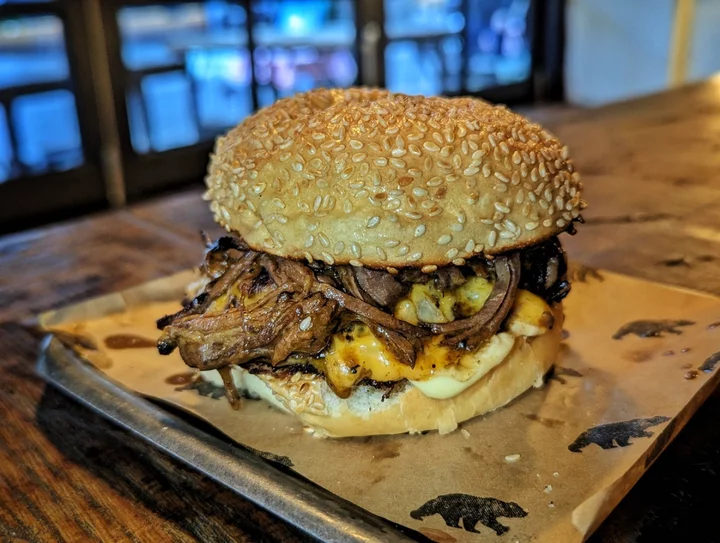
10 best burgers in London: We tried and tested everything from plant-based patties to a Tomahawk steak
When you get a burger craving, there is little else that can satisfy it. If you’re someone who simply cannot make do with a sub-par patty, then you’re in good company and luckily for you, we’ve rounded up the best burgers to feast upon in London. While we do tend to get these burger cravings more than we’d like to admit, we’ve actually selflessly gone out to test the best that this city has to offer – whether that’s at the OG spots we all know and live or to help you try something completely new. From beef and chicken options to plant-based patties, there’s something for everyone. For example, indulge in a dirty burger from Five Guys, an OG classic from Bleecker or be of the opinion that sometimes the humble patty alone just isn’t enough – enter a 1kg tomahawk (yes, you read correctly). Whatever you’re feeling, this list should have you covered. Burgers and Beats A newcomer to the scene, Burgers and Beats has only been around since 2021. However, in that short space of time it’s fast cemented itself as one of London’s best burger offerings. You may have seen that iconic tomahawk burger making the rounds on Instagram – and we can confirm it’s not just a novelty. Every bit of it (complete with a fried egg, pico de gallo salsa, chimichurri and more) is absolutely delicious. However, the standard menu is also worth considering with the smashed double cheese and “east meets west” (with sweet chilli syrup and chimichurri mayo) being two of our all-time favourites in London. Also, do leave some room for the chicken tenders and loaded fries as they’re both excellent and worth stretching your stomach a little more for. burgersandbeats.co.uk Burger and Beyond Ah, we remember Burger and Beyond back in the days of the Camden Market stall… then its residency at the Camden Assembly. Well, it’s quite a different kettle of fish now, with four permanent sites up and running. Dining at the OG bricks and mortar spot in London’s Shoreditch, one bite of the “bougie” burger takes us straight back to those early days, but also proves just how far this place has come. Other standouts include the mushroom raclette burger (demonstrating that burgers most definitely do not have to be beef) and the vegan “chicken” entry with Korean sauce and gochujang mayo. We did love the krispie chicken, too, though we wished the miso butter was more prominent. If you’re not a burger fan (weird), we’d also recommend the trio of tacos, or the stellar dirty tots and bone marrow gravy fries. burgerandbeyond.co.uk Bleecker Potentially London’s favourite burger joint, Bleecker is undeniably committed to its cause, with founder Zan Kaufman trying to recreate the moment of euphoria she experienced upon trying “the best burger she had ever eaten” in New York on this side of the pond. From a burger truck to its first kiosk in Spitalfields Market, then bricks and mortar restaurants, it’s been years but this burger joint is still going strong. Again, keeping things simple, the most adventurous it gets is adding blue cheese or Neil Rankin’s symplicity burger to the menu. Burgers can be at their best this way and at Bleecker, the double cheeseburger is more than enough to satisfy any craving. bleecker.co.uk Punk Chef You can find professional chef and TV presenter Scott Garthwaite’s food truck in East London’s Spitalfields Market, which not only serves mouthwatering burgers but also employs three members of staff from the deaf community. We got our hands (and mouths) on Punk Chef’s classic number “The Legend”, which is essentially a chicken parm burger (though plant-based escalopes are also available) with homemade bechamel sauce, melted cheese, gherkins and a special burger sauce. A standout among London’s already top burger offering. punkchef.co.uk Blacklock Known for its chops and iconic Sunday roast, we’d also heard great things about the Blacklock burger. If you’re dining there but don’t fancy chops or steak, the burger offers so much more. Potentially more enjoyable, in our opinion, the double cheeseburger is packed full of onions that have been caramelised in “a healthy glug of vermouth”. Beautifully rich – but not overly so – and also a decent size. We have to say that while the rising trend of “the bigger, the better” may suit some, it might be overreaching for the humble burger. Bravo, Blacklock – we’ll be back for this one. theblacklock.com Black Bear Another London burger staple and one whose market stall days we still remember, Black Bear proves it’s an oldie but a goldie. You can’t come here and not get the Black Bear with cheese, smoked bacon and onion jam. However, the brisket burger, with 12-hour braised meat, and the miso bacon burger, with miso honey butter mayo, are very good choices, too. Share two and take one home for later? Also indulge in the cheeseburger spring roll, one of the restaurant’s signature snacks. blackbearburger.com Shake Shack Yes, we know everyone is well aquainted with the New York burger chain, but Shake Shack has come a long way since its days of being a hot dog stand in Madison Square. Originally the class “roadside” burger, what we really love about Shake Shack is the size. Like we said earlier, bigger doesn’t necessarily mean better and whether you go for a single or double patty here, Shake Shack burgers tend to hit the spot every time. While our frontrunner remains the Shackmeister (with those perfectly crispy ale-marinated shallots), the vegan crispy shallot burger is another one of our favourites. shakeshack.co.uk Coqfighter We’ve been pretty focused on beef burgers up until now – although still acknowledging the delicious vegan versions those burger brands have to offer – but here’s a spot that knows its stuff when it comes to fried chicken. It seemed only fitting that we tried the variety of sides on the menu, with the laksa butter wings and classic buffalo options taking centre stage. Don’t worry – we left room for the burgers, and thoroughly enjoyed devouring the iconic green chilli cheeseburger, featuring chipotle mayo and pickled green chilli. The honey ginger buffalo (what better string of words or ingredients is there?) is also a strong choice – but beware, it’s a messy one. coqfighter.com The Beaumont Stepping away from the classic burger joints, there are many standard restaurants in London that serve up burgers to rival those whose sole purpose is to cook them. The Beaumont is one of these spots, with Gatsby’s Room, situated in the centre of the hotel, offering the perfect escape from the buzz of central London. The Beaumont cheeseburger features a juicy patty on top of caramelised onions and is slathered with a rich and moreish secret sauce – proving that a good old fashioned favourite can still leave a lasting impression. Served with thick cut chips, it’s ideal for anyone who fancies a more decadent setting when devouring such a meal. thebeaumont.com Five Guys Another American food chain to make a long-lasting impression on the UK burger community, Five Guys is exactly where our brain goes when we think of the ultimate dirty burger. Things are kept simple, with a hamburger, cheeseburger, bacon burger and bacon cheeseburger on that side of the menu (the chain also includes hot dogs and various sandwiches, too) and if you ever have that intense craving, this may be the place to satisfy it. While a tricky one for anyone with a nut allergy (the chips are fried in peanut oil), the burgers come with two patties as standard and can be washed down with one of the many milkshake flavours on offer. If you want to cement yourself as a firm fan, Five Guys has also released its own line of merchandise so you can fully embrace the burger brand. fiveguys.co.uk So we’ve covered food and now what about wine? Meet the sommeliers who are breaking the industry’s stuffy stereotype Read More The best outdoor restaurants, terraces and rooftop bars in London to book now The best outdoor restaurants, terraces and rooftop bars in London to book now Is bottomless prosecco going to be killed off by climate change? Thrifty and fruit coconut, raspberry and chocolate muffins
2023-09-07 17:16

Is bottomless prosecco going to be killed off by climate change?
Picture this. The group chat has finally settled on a date and we are going out. Out out. Women of most ages know how serious this is. There was probably a spreadsheet involved. Boyfriends and husbands have been dispatched to the pub. Children and dogs have been dropped off at the sitter. Dignity has been left at the door. One of us is waiting for it to be cancelled so we can stay at home with our loungewear and girl dinners (it’s probably me). There’s only one thing for it. Bottomless brunch. Many Asos orders and outfit changes later, we arrive, take our seats and start the binge drinking timer. There’s only one problem. No prosecco. Freshly manicured fists pound the table. The elected Karen of the group starts to verbally pulverise the staff. Eggs Benedicts are thrown against the walls. The Prosecco Huns exclaim in unison: “But what are we going to drink now?!” The waiter bashfully suggests: “Spumante?” Give over. According to a new study, this could be a reality in the near future thanks to climate change threatening vineyards across Europe, in particular those dedicated to glera (the beloved prosecco grape) in Northern Italy. In a detailed report in iScience last month, researchers warned that unpredictable weather, soil degradation and drought could lead to the loss of a millennia-old winemaking tradition, and the livelihoods attached to it. RIP the Prosecco Hun. The Italian sparkling wine has long been the fizz of choice in the UK (we were only dethroned as the world’s biggest prosecco guzzlers last year by the US). In the early 2010s, more than a third of all the prosecco shipped out of Italy worldwide ended up in Britain – approximately 131 million bottles a year. That’s nearly two bottles per Brit. You get the idea. The origin of our obsession with prosecco dates back to just after the 2008 crash, when consumers were looking for an alternative to expensive champagne. The softer tasting, far more affordable (thanks to its cheaper and speedier production time) and incredibly quaffable prosecco was the obvious choice. Bottomless brunch was born. “My heart goes out to the huns whose weekends simply aren’t complete without a bottle of prosecco,” Hannah Crosbie, founder of Dalston Wine Club, laments at the news that just 15 years after it stormed onto supermarket shelves, prosecco might be quietly forced to say arrivederci. “In all seriousness though, climate change is seriously threatening every aspect of winemaking, and growing conditions are only getting more challenging.” Prosecco is certainly not the only vino at risk, but it faces a unique issue. Where other wine growing regions affected by climate change such as Champagne and Burgundy can simply put out a limited run with an inflated price tag and keep the snobby oenophiles coming, prosecco’s USP is its ability to produce in bulk and at a fraction of the cost. English sparkling is a big winner with the climate going the way it is. Prosecco, by all accounts, seems like it’s a bit of a loser in that regard Will Amherst, head wine buyer at Trullo Ali Finch, group sommelier at Angela Hartnett’s Michelin-starred Italian restaurant Murano in Mayfair, doesn’t believe there’s an appetite for a higher quality, more expensive prosecco. “With the impact of the climate as well as the cost of producing wine increasing, the challenge for prosecco is going to be how to balance the expectation of its price point with the need to make slightly smaller quantities,” she tells me. “Regions like Chablis, for instance, have had multiple horrible vintages back to back and people just accept the fact they have to pay more for it if they want to drink that wine.” For the uninitiated, the word “vintage” on a wine label simply means the year the grapes were harvested – compared to regular wines that may include grapes harvested in multiple years – and each vintage can taste vastly different based on the conditions affecting the grapes in that year. Chablis, produced from chardonnay grapes in the northernmost district of Burgundy, has always been particularly affected by the climate due to its geography, but in recent years has seen frost in 2016, 2017 and 2021, and drought and higher temperatures in 2019 and 2020. This has dramatically affected those vintages, and driven up the price of bottles from “good” years. But with prosecco, “people potentially wouldn’t be interested in” paying a higher price, Finch says. This is partly because its brand has become more associated with cheap fizz than fine wine in Britain. Part of the problem also lies in the simplicity of its production. Prosecco is a wine that reflects the aromatics of the grape at the point of harvest, whereas with other sparkling wines like champagne, as well as other types of wine in general, such as chablis, it’s about the ageing process. Rising temperatures mean grapes are ripening more quickly, which can result in a different flavour of wine or too much alcohol, so one option is to harvest the grapes earlier. You can get away with a slightly under-ripe fruit in aged wines as so much of the flavour is added during their long fermentations. In prosecco, a bottle of which is ready in just 30 days, an under-ripe grape could result in something that “tastes a lot like battery acid”, according to Finch. The Prosecco Huns don’t want to chug something flavourless and eye-wateringly alcoholic with their eggs Benedict. “If you pick too early, you’ve got no flavour,” Finch explains. “So they don’t really have the option to just keep making it in the same volume. With other wines, you can do more work in the winery to make the wine feel more balanced and more approachable and more complex. They don’t have that luxury in prosecco.” Under Italy’s DOC (Denominazione di Origine Controllata) laws, prosecco is only prosecco when it comes from just two regions of the country, Veneto and Friuli-Venezia Giulia, and adheres to strict growing and production rules. The same goes for champagne: only wine produced from eight permitted varieties of grape grown exclusively in the Champagne region of France may be called champagne. It’s these “heroic viticulture” sites that the report says are most at risk. Naming rights have been a point of contention across the whole wine industry for some time, with Australian producers of glera recently putting in a request to the EU to be allowed to call their wine prosecco on the grounds that it’s part of their migrant and cultural identity. Ironically, the glera grape is actually believed to be Slovenian in origin, and was first cultivated in the vineyards of Prosecco, a small village in the Friuli-Venezia Giulia region near the border with Slovenia. The name is even thought to derive from the Slovenian words preseka or poseka, or the Serbian/Croatian prosek, meaning “path cut through the woods”. While DOC laws might prevent anyone calling a sparkling wine made from glera grapes outside of the designated regions a prosecco, it hasn’t stopped winemakers around the world from essentially producing the same wine using the same techniques. As climate change has made it increasingly difficult to cultivate the grapes in their historical home, it’s also made conditions in more northern regions like the UK more favourable for the growing of certain grapes, including white varieties such as glera, opening the door to a whole new generation of winemakers. “This is not me saying this is the death of prosecco,” Finch adds quickly, but she stresses that the wine industry is naturally very dynamic. “There are loads of alternatives to prosecco, both within Europe in terms of pet nats and cremants and things like that, and with the New World as well.” Pet nats – sparkling wines made using the “traditional method” of fermenting in individual bottles – have become very trendy among the younger Gen Z crowd, she says, as it still offers something bright, fruity and super fizzy, but without the faff, or price tag, that comes with champagne. People are also drinking less but are happy to spend a little more and not drink as much. At Murano, Finch says diners are asking about English sparkling wines more than ever before. “The correlation, obviously, with post-Brexit is there. There’s a desire to try and drink more local wines, potentially from a sustainability point of view, potentially from a cost-to-quality point of view because of duty increasing. It’s also partly because during Covid people did a lot of staycations and UK wine tourism did very well during that time. And it sort of stuck.” It’s a sentiment echoed by Will Amherst, head wine buyer at Italian trattoria Trullo in Islington, north London. “I don’t want to bash prosecco too much, but if I was going out and I wanted sparkling wine, I would still look at champagne,” he says, much to the chagrin of the Prosecco Huns. “And if I’m going to look somewhere other than that, I would get a bottle of English sparkling. Because English sparkling is a big winner with the climate going the way it is. Prosecco, by all accounts, seems like it’s a bit of a loser in that regard.” Prosecco and the people that produce it are certainly not the only losers but its high-altitude, cooler temperature geography, which previously protected it from climate change, is now adversely affected by extreme weather. Sudden, intense rainfall damages the soil and creates “slope failures”, while conversely droughts make irrigation extremely difficult. While he’s yet to see a knock-on effect on prosecco supplies at Trullo, Amherst’s “immediate thoughts were, really sadly: is prosecco going to be able to pull itself out of that hole? I don’t know how you reconcile the spiralling production costs and the brand identity, which is synonymous with cheap wine in this country,” he says. Although it’s not recommended to keep prosecco longer than two to three years before it goes flat – compared to up to 10 years for vintage champagnes – he doesn’t anticipate stocks to run down soon. At any rate, his biggest use for prosecco at Trullo is in an Aperol Spritz, where it makes up half the drink. He actually sees it as an exciting opportunity for new wines to emerge. So does Will Hill, a wine buyer at online merchant Honest Grapes, who tells me: “Once again, cava is showing that there is great value to be found in traditional method sparkling wines and more and more we are seeing ‘prosecco-esque’ wines for lower prices. If the consumer isn’t tied to the name ‘prosecco’, there are plenty of good, affordable, entry-level options available.” It’s clear that wines of all colours are facing an uphill battle (quite literally in prosecco’s case), not just to survive but to protect their identity, which for prosecco is arguably more important. That could spell the end of the Prosecco Hun, but with English sparkling and other European varieties on the rise, perhaps it just means a rebranding is in order. Cremant Crew? Pet Nat Posse? They don’t have quite the same ring, but it won’t stop us booking bottomless brunch anytime soon. Read More I feel it in my fingers: Why more of us should start eating with our hands Pizza, cake and meringue martinis: When did cinema food get so silly? Michelin-starred chef Simon Rogan on 20 years of L’Enclume: ‘It all started with a radish’
2023-09-06 15:29

Hermine Dossou: Being thrifty in the kitchen helped me get on the housing ladder
As a trained accountant and a long-time baking enthusiast, Hermine Dossou knows a thing or two about saving money in the kitchen. “My first breadmaker was from Panasonic – I bought it from Gumtree,” the former Great British Bake Off contestant says. “It was basically somebody’s wedding present that they didn’t want and they sold it half price.” A devotee of Martin Lewis’s Money Saving Expert website, the 42-year-old, who was born in Benin, West Africa, and moved to the UK for university aged 20, tries to avoid ever paying full price for a big ticket item. “If I wanted to buy, let’s say, a mixer, I would go online, and type ‘Kenwood discount vouchers’ and then something always comes up,” says Dossou, who lives in Kettering and came fourth on the 2020 series of Bake Off. But the mum-of-one – whose son Steven is 13 – wasn’t always such a frugal foodie. “That came from that period where I became a single mum on a reduced income,” she says. “I couldn’t work full-time because I had to look after my son, and also I didn’t want him to have the processed kind of bakes.” Whipping up cakes and cookies filled her “empty afternoons” as a new mum and was a lot cheaper than buying ready-made baked goods. “I would cook from scratch and prep my vegetables when I could get them on offer,” she continues. “Same for fruits – they are often very discounted when they become a bit soft, and that’s the best time to make jam.” Even post-Bake Off and her book deal (she works full-time as an accountant), Dossou remains a savvy shopper, knowing that a higher price doesn’t always mean a better product. “Like a bar of chocolate, if it’s the same quantity of cocoa, why are you paying three times the price? Especially if you’re going to bake with it. “Wonky onions at half the price is the same… they all come from the same farm.” Her accountancy skills came in handy, too, and she still uses a spreadsheet to track her income and outgoings every month. “I think generally in life it is important to budget and know where your money goes, because I think it allows you to achieve a lot more than if you were just living freestyle,” Dossou says. “It’s a nightmare trying to get on the housing ladder here in the UK – that’s something I’ve been able to do through being thrifty in every area of my life.” That’s why she decided to call her first cookbook The Thrifty Baker: “I just really wanted to bring that awareness of how we choose what we eat, and how we can save through making little changes here and there.” “Now, more than ever, when people are struggling with the cost of living, I think it’s even more important to go back to those values of cooking from scratch, trying to cook at home, and making meals from, you know, not much.” With lots of advice for beginners, the book focuses on affordable dishes, from basic breads and simple biscuits to special occasion puds and impressive-looking desserts. There’s a distinct Gallic influence (Benin, where Dossou learned to bake as a child, is a former French colony) felt with recipes such as pain de campagne, orange and brown butter madeleinesm and pear frangipane tart. The author points out when a recipe can be cooked in an air fryer – a recent Black Friday bargain she loves because it allows her to enjoy fried Benin delicacies using less oil and without turning on the oven. “Because we have a really small family, just me and my son, you don’t always want to put the oven on just to bake something for two. “With an oven you’ll need to preheat it for a good 15 to 20 minutes before you can even bake in it. With the air fryer you just put the cake in and 15 minutes later it’s out – easy and convenient.” There’s also a section devoted to microwaveable mug cakes, with peanut butter and jam, speculoos (aka Biscoff) and chocolate hazelnut flavours of the cheap and easy-to-make single-serve puds. “In the microwave you can make a cake in five minutes from weighing, mixing and baking,” says Dossou, who loves how kid-friendly they are. “With my son I feel more inclined to let him make a mug cake than maybe something bigger. “Even if it goes wrong he’s not wasting a lot of ingredients and, you know, he’s not turning the kitchen into a bonfire.” ‘The Thrifty Baker’ by Hermine Dossou (White Lion, £18.99).
2023-09-06 13:58
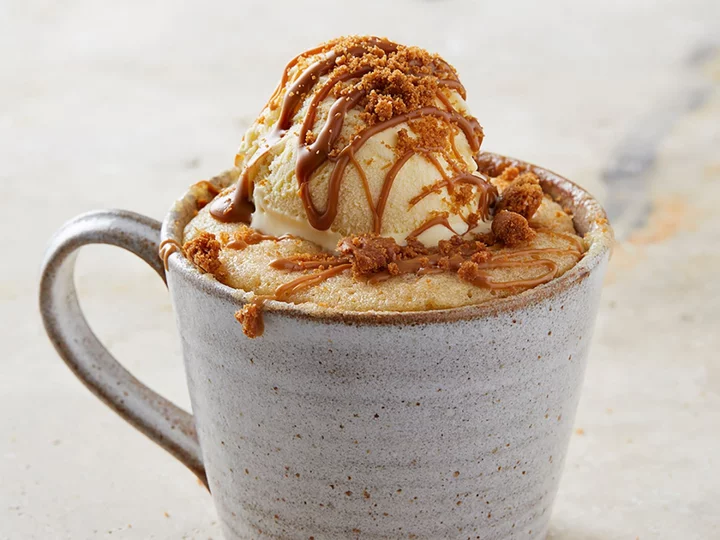
For a quick sugar fix, try this Biscoff microwave mug cake
Microwave cakes will never replace an oven-baked cake, in my opinion, because good things take time to create,” says former Great British Bake Off contestant, Hermine Dossou. “That said, when you don’t have an oven, when you’re not in your own kitchen with your own equipment, when you’re limited by time, or even have just a few bits of ingredients here and there, microwave mug cakes make a great substitute. And they’ll help you get rid of that sugar craving!” Speculoos mug cake Serves: 1 Ingredients: 30g salted butter 1 tsp speculoos spread 40g sugar 25g whole milk 1 small egg 40g self-raising flour 1 tsp vanilla extract For the topping: 1 tbsp speculoos spread 1 scoop vanilla ice cream 1 speculoos or other biscuit, for crumbling Method: 1. Put the butter and speculoos spread in a large mug and microwave on medium–high power (600 watts) for 10-20 seconds. Stir until smooth. 2. Add the sugar and milk and stir until combined. Then add the egg and mix vigorously with a whisk or small spatula to avoid streaks of egg white in your cake. 3. Finally, add the flour and vanilla, mixing thoroughly to ensure there are no lumps. 4. Microwave on medium–high (600 watts) for one minute. Keep an eye on the cake as each microwave cooks differently. You want the batter to be only just cooked; when you lightly touch the top, it should feel slightly sticky. If it feels completely dry, you have overcooked your cake. Remove from the microwave and allow to cool. 5. To serve, melt the one tablespoon of speculoos spread in the microwave for about 10 seconds. Top the cake with a scoop of vanilla ice cream, drizzle with the melted speculoos spread and sprinkle with the crumbled biscuit. Enjoy. ‘The Thrifty Baker’ by Hermine Dossou (White Lion, £18.99).
2023-09-06 13:54
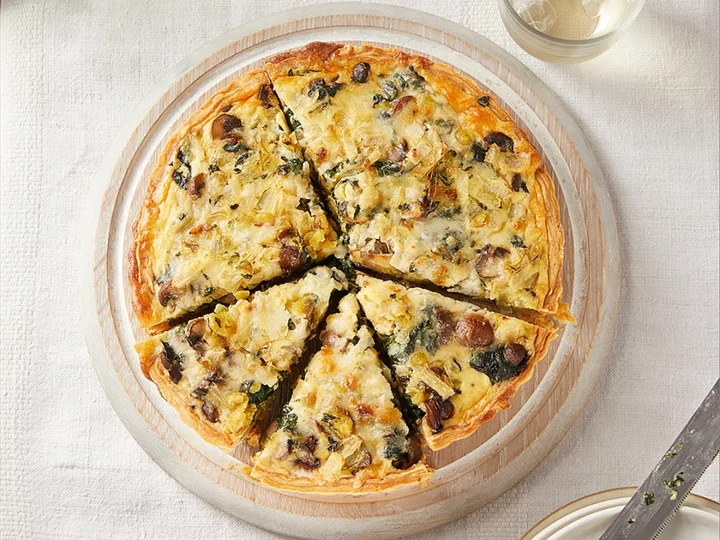
How to make spinach and mushroom quiche
It’s often said that quiche is old-fashioned, but there is nothing old-fashioned about this one,” says former Great British Bake Off contestant Hermine Dossou. “It’s a crumbly, super-short, melt-in-your-mouth pastry filled with buttery spinach and creamy custard. “Gruyère is the perfect cheese for quiche and a little goes a long way, but if it’s not available, you can substitute with Emmental, Comté, Jarlsberg or Beaufort.” Spinach and mushroom quiche Serves: 8 Ingredients: For the shortcrust pastry: 210g plain flour (gf plus 1 tsp xanthan gum), plus extra for dusting 130g cold butter 1 large egg (55g) 1 tbsp cold water ¼ tsp salt For the custard: 15g butterLeaves from 3 thyme sprigs 1 small yellow onion (about 50g), finely chopped 2 eggs 120g double cream 1 chicken or vegetable stock cube, crumbled 1 tsp Dijon mustard ¼ tsp salt Pinch of black pepper For the filling: 30g butter 250g mushrooms, sliced ½ tsp garlic powder A pinch of salt 250g baby spinach leaves 80g grated Gruyére cheese Method: 1. To make the shortcrust pastry, in a large bowl rub the flour and butter together with your fingertips until sandy in texture. (You can use a food processor to speed up this process.) Add the egg, water and salt and bring together into a dough without overworking it. Wrap in cling film and chill in the fridge – you always want to work with cold pastry as it’s much easier to handle. 2. When ready, lightly flour a work surface and roll out the dough to a circle about 30cm in diameter and 3mm thick. Use your rolling pin to lift it up and lay it over a 23cm tart tin, so there is an overhang of pastry at the top. Using a straight-sided glass, ease the pastry into the corners of the tin by rolling the glass around the edge in circular motion. Chill for 20 minutes. 3. Preheat your oven at 200C/180C fan/400F/Gas 6. Line your chilled pastry case with parchment paper, fill it with baking beans or cheap pulses, and blind bake for 15 minutes. Lift out the baking beans and parchment paper and continue baking for a further 10 minutes to dry out the base. 4. Meanwhile, make the custard. Put the butter, thyme and onion in a small frying pan over medium heat and cook until the onion is soft and transparent. Set aside to cool slightly. In a medium bowl, whisk together the eggs, cream, stock cube, mustard, salt and pepper, adding the cooked onions. Set aside. 5. Prepare the filling using the same pan you used to cook the onions. Heat the butter, add the mushrooms, garlic and salt, and cook over a high heat until the mushrooms are soft and most of the water has evaporated. Add the spinach and cook until it has wilted and the mixture is thick. 6. Tip the spinach mixture into the pre-baked tart case and spread it around evenly. Sprinkle over the grated cheese, then pour in the custard, making sure it’s distributed evenly. Bake at 200C/180C fan/400F/Gas 6 for 20–25 minutes, or until the middle of the quiche looks set and the top is slightly golden. Enjoy warm. ‘The Thrifty Baker’ by Hermine Dossou (White Lion, £18.99).
2023-09-06 13:50
